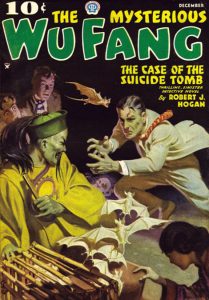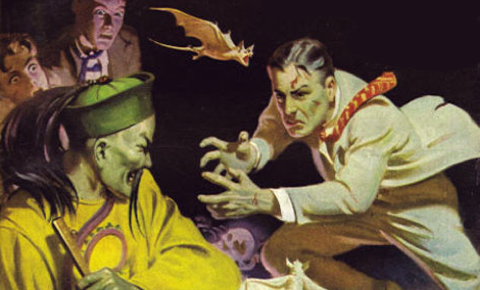
Context is a challenge in politically correct times that seek to view the past through the myopic lenses of an eternal present. What remains of pulp fiction’s past is largely through the efforts of specialty publishers who keep these classic works in print for a niche market that still reads stories from a simpler, different — though not always better — world.
Much of the last century’s fantastic fiction sprung directly from colonial viewpoints of the British Empire. Among the xenophobic byproducts of colonialism in popular culture was the Yellow Peril, the paranoid delusion that Chinese immigrants were plotting to conquer the West. There was certainly crime in Chinatown: there is always crime among the economically underprivileged. However, what made the Yellow Peril thrive as a sub-genre of the thriller was the creation of a brilliant, amoral criminal mastermind
Sax Rohmer’s Fu Manchu became the personification of the Yellow Peril. Without the character’s introduction, the sub-genre would never have prevailed. Fu Manchu took the reading public by storm just before the outbreak of the First World War. The series remained a bestselling franchise up to the Cold War. Rohmer’s insidious fiend was everywhere: magazines (slicks, not pulps), books, newspaper strips, comic books, radio series, films, the theater, and eventually television.
Popular Publications gave readers the most memorable Fu Manchu imitations with Robert J. Hogan’s pulp title, THE MYSTERIOUS WU FANG, and its successor, Donald Keyhoe’s DR. YEN SIN. Wu Fang was pitted against G-man Val Kildare, an American variation on Fu Manchu’s nemesis, Sir Denis Nayland Smith of British Intelligence. Kildare, like Smith before him, was complemented by his own Watson, news correspondent Jerry Hazard.
Closely following the established Fu Manchu formula, Wu Fang’s unwilling femme fatale, Mohra, fell in love with Hazard. She would repeatedly betray her master to spare the lives of Kildare and Hazard. Mindful of the audience demographics for pulp magazines, THE MYSTERIOUS WU FANG featured the reader identification character of Cappy, a spunky newsboy and boy scout who improbably accompanied Kildare and Hazard on their globe-spanning adventures.
Popular Publications employed Rohmer’s artist, John Richard Flanagan, to provide his lurid Yellow Peril interior artwork for each month’s stories. While there were many Fu Manchu imitations in the 1930s, THE MYSTERIOUS WU FANG looked and read almost like the genuine article and was providing readers with a new short novel each month. After Popular Publications received a cease and desist letter from Rohmer’s attorneys, THE MYSTERIOUS WU FANG was promptly cancelled after its seventh issue. Afterward, Popular Publications reworked the concept with a similar character.
The replacement title was DR. YEN SIN. While there was no mistaking Donald Keyhoe’s Yen Sin as another variation on Fu Manchu, his nemesis was not another clone of Nayland Smith or Val Kildare, but a unique pulp hero who deserved greater recognition. Yen Sin faced Michael Traile, a G-man dependent upon yoga, due to a freakish medical condition that prevented him from ever sleeping. Traile was ably supported by yet another newspaper correspondent, Eric Gordon.
Dr. Yen Sin belonged to an international criminal organization, the Invisible Empire, where he was known by the code name, the Cobra. Keyhoe detailed the character’s backstory involving the abduction of the Russian Grand Duke Damitri and Michael Traile’s first encounter with Yen Sin in China after the Great War.
Unfortunately, these points were drawn directly from Sax Rohmer’s 1918 Yellow Peril thriller, THE GOLDEN SCORPION. It was part of the Fu Manchu continuity and featured Fo-Hi, known within the international criminal organization, the Sublime Order, by the code name, the Scorpion. Fo-Hi was likewise first glimpsed by the hero in China several years before the novel takes place. He was likewise involved with the removal of a Russian Grand Duke just before the First World War.
DR. YEN SIN made the same mistake that brought THE MYSTERIOUS WU FANG to a premature end by steering too closely to Rohmer. The third bi-monthly issue of DR. YEN SIN had just gone to press when Popular Publications cancelled the series following a further cease and desist letter initiated by Rohmer’s attorneys. Perhaps without John Richard Flanagan’s artwork, so synonymous with Rohmer’s work, they might not have attracted so much unwanted attention.
More likely it was a combination of factors, the most important of which was a monthly (or bi-monthly) pulp title imitating (and sometimes outdoing) Rohmer. This was perceived as a threat to Fu Manchu’s marketability, particularly since each new Rohmer novel was vied for by the slicks for serial rights. If the pulps now had their own Chinese criminal mastermind using Rohmer’s favored Fu Manchu interior artist, then Rohmer’s property diminished in value for both publishers and readers.
For just over a year, Popular Publications gave readers the next best thing to Rohmer’s Devil Doctor. THE MYSTERIOUS WU FANG and DR. YEN SIN are familiar, but stand on their own as classic pulp thrillers in the Yellow Peril sub-genre. Keyhoe, like Robert J. Hogan before him, is among the best of the Yellow Peril authors to follow in Fu Manchu’s wake.
Altus Press has reprinted all ten issues comprising the complete run of these two collectible titles as affordable digest-sized trade paperbacks. PulpFest 2019 will see the debut of the hardcover omnibus edition of DR. YEN SIN featuring bonus text features and introductory material not included in the trade paperback editions.
There is no denying the inherent racism of Yellow Peril fiction. Much like minstrel shows, the racism is its reason for existing. At its best, yellow peril fiction offered readers exotic thrills and excitement that dared them to imagine adopting the values and mores of a different culture, one that withstood Western imperialism and tempted readers with greater knowledge and power as well as the lusty allure of something far more dangerous and pleasurable than they could ever find back home.
PulpFest 2019 will begin on Thursday, August 15, and run through Sunday, August 18. Join PulpFest at the DoubleTree by Hilton Hotel Pittsburgh – Cranberry, just north of Pennsylvania’s “Steel City” of Pittsburgh. We’ll be celebrating “Children of the Pulps and Other Stories” at this year’s gathering. Click our Programming button below our homepage banner to get a preview of all the great presentations at this year’s event.
To join PulpFest 2019, click the Register button below our homepage banner. To book a room at the DoubleTree by Hilton — our host hotel — click the Book a Room button, also found on our homepage.
(In 1935 – 36, Popular Publications tested the market for a yellow peril pulp. It launched THE MYSTERIOUS WU FANG, beginning with the September 1935. All of the stories — including “The Case of the Suicide Tomb” — were written by Robert J. Hogan, best known as the author of the series, G-8 AND HIS BATTLE ACES. The pulp lasted for seven issues and featured cover art by Jerome Rozen, including the cover for the December 1935 number.
Next came DR. YEN SIN, again featuring cover art by Jerome Rozen. The series premiered with its May-June 1936 number and ran for three issues. All of the stories were written by Donald E. Keyhoe. He is remembered for his air war stories featuring Captain Philip Strange. Later in life, he became well known as a UFO researcher.)






